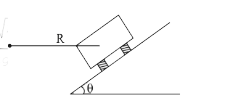A car is moving in a horizontal level of circular track with uniform speed of 10ms. If radius of circular path is 50 m then the minimum coefficient of friction to avoid over turning is
0.3
0.5
0.1
0.2
The correct Answer is:D
To solve the problem of finding the minimum coefficient of friction required to avoid overturning for a car moving on a circular track, we can follow these steps:
1. Identify the Given Values:
- Speed of the car, v=10m/s
- Radius of the circular path, R=50m
- Acceleration due to gravity, g=10m/s2 (standard value)
2. Understand the Forces Acting on the Car:
- When the car is moving in a circular path, it experiences a centripetal force directed towards the center of the circle.
- The frictional force provides the necessary centripetal force to keep the car moving in a circle.
3. Centripetal Force Equation:
- The formula for centripetal force is given by:
Fc=mv2R
- Here, m is the mass of the car, v is the speed, and R is the radius of the circular path.
4. Frictional Force:
- The maximum frictional force that can act on the car is given by:
Ff=μN
- Where μ is the coefficient of friction and N is the normal force. For a level surface, N=mg.
5. Setting Up the Equation:
- To avoid skidding, the frictional force must be equal to the required centripetal force:
μmg=mv2R
- Here, we can cancel m from both sides since it appears in both terms:
μg=v2R
6. Solving for the Coefficient of Friction:
- Rearranging the equation gives:
μ=v2gR
7. Substituting the Values:
- Now substituting the known values into the equation:
μ=(10)210×50
- This simplifies to:
μ=100500=15=0.2
8. Conclusion:
- Therefore, the minimum coefficient of friction required to avoid overturning is:
μ=0.2
Final Answer:
The minimum coefficient of friction to avoid overturning is 0.2.
---
- Speed of the car, v=10m/s
- Radius of the circular path, R=50m
- Acceleration due to gravity, g=10m/s2 (standard value)
- When the car is moving in a circular path, it experiences a centripetal force directed towards the center of the circle.
- The frictional force provides the necessary centripetal force to keep the car moving in a circle.
- The formula for centripetal force is given by:
Fc=mv2R
- Here, m is the mass of the car, v is the speed, and R is the radius of the circular path.
- The maximum frictional force that can act on the car is given by:
Ff=μN
- Where μ is the coefficient of friction and N is the normal force. For a level surface, N=mg.
- To avoid skidding, the frictional force must be equal to the required centripetal force:
μmg=mv2R
- Here, we can cancel m from both sides since it appears in both terms:
μg=v2R
- Rearranging the equation gives:
μ=v2gR
- Now substituting the known values into the equation:
μ=(10)210×50
- This simplifies to:
μ=100500=15=0.2
- Therefore, the minimum coefficient of friction required to avoid overturning is:
μ=0.2
The minimum coefficient of friction to avoid overturning is 0.2.
Topper's Solved these Questions
Similar Questions
A car is moving in a horizontal level circular track with uniform speed v. If R is the radius of circular path, then the minimum coefficient of friction to avoid over turning is
View SolutionA particle is moving around a circular path with uniform angular speed (x) . The radius of the circular path is (r). The acceleration of the particle is:
View SolutionA car is moving on a circular road which is rough and banked at angle . If radius of circular track is R then. Choose correct statement:

View SolutionA coin is placed at the edge of a horizontal disc rotating about a vertical axis through its axis with a uniform angular speed 2 rad s−1. The radius of the disc is 50 cm. Find the minimum coefficient of friction between disc and coin so that the coin does not slip. (Take g=10m/s2)
View SolutionA particle moves in a circular path with a uniform speed. Its motion is
View SolutionA car of maas M is moving on a horizontal circular path of radius r. At an instant its speed is v and is increasing at a rate a.
View SolutionA car moving around a circular track with uniform speed is in …………...…….(non-uniform motion/uniform motion).
View SolutionA particle of mass m is moving on a circular path of radius r with uniform speed v , rate of change of linear momentum is
View SolutionA car is moving on a horizontal circular track of radius 0.2 km with a constant speed. If coefficient of friction between tyres of car and road is 0.45, then maximum speed of car may be [Take g=10m/s2]
View SolutionA car is moving on a horizontal circular road of radius 0.1 km with constant speed. If coefficient of friction between tyres of car and road is 0.4, then speed of car may be (g=10m/s2)
View Solution
